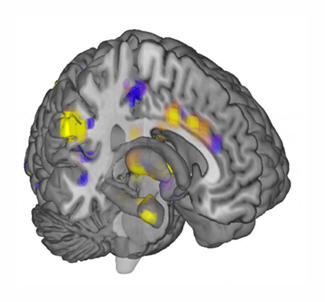 |
| Image credit: Tor D. Wager, CU Boulder |
First Objective Measure of Pain
Discovered
in Brain Scan Patterns
CU, Boulder; April 10, 2013—For the first time, scientists have been able to predict how much pain people are feeling by looking at images of their brains, according to a new study led by the University of Colorado Boulder.
The findings, published today in the New England Journal of Medicine, may lead to the development of reliable methods doctors can use to objectively quantify a patient’s pain. Currently, pain intensity can only be measured based on a patient’s own description, which often includes rating the pain on a scale of one to 10. Objective measures of pain could confirm these pain reports and provide new clues into how the brain generates different types of pain.
The new research results also may set the stage for the development of methods using brain scans to objectively measure anxiety, depression, anger or other emotional states.
“Right now, there’s no clinically acceptable way to measure pain and other emotions other than to ask a person how they feel,” said Tor Wager, associate professor of psychology and neuroscience at CU-Boulder and lead author of the paper.
The research team, which included scientists from New York University, Johns Hopkins University and the University of Michigan, used computer data-mining techniques to comb through images of 114 brains that were taken when the subjects were exposed to multiple levels of heat, ranging from benignly warm to painfully hot. With the help of the computer, the scientists identified a distinct neurologic signature for the pain.
“We found a pattern across multiple systems in the brain that is diagnostic of how much pain people feel in response to painful heat.” Wager said.
Going into the study, the researchers expected that if a pain signature could be found it would likely be unique to each individual. If that were the case, a person’s pain level could only be predicted based on past images of his or her own brain. But instead, they found that the signature was transferable across different people, allowing the scientists to predict how much pain a person was being caused by the applied heat, with between 90 and 100 percent accuracy, even with no prior brain scans of that individual to use as a reference point.
The scientists also were surprised to find that the signature was specific to physical pain. Past studies have shown that social pain can look very similar to physical pain in terms of the brain activity it produces. For example, one study showed that the brain activity of people who have just been through a relationship breakup—and who were shown an image of the person who rejected them—is similar to the brain activity of someone feeling physical pain.
But when Wager’s team tested to see if the newly defined neurologic signature for heat pain would also pop up in the data collected earlier from the heartbroken participants, they found that the signature was absent.
Finally, the scientists tested to see if the neurologic signature could detect when an analgesic was used to dull the pain. The results showed that the signature registered a decrease in pain in subjects given a painkiller.
The results of the study do not yet allow physicians to quantify physical pain, but they lay the foundation for future work that could produce the first objective tests of pain by doctors and hospitals. To that end, Wager and his colleagues are already testing how the neurologic signature holds up when applied to different types of pain.
“I think there are many ways to extend this study, and we’re looking to test the patterns that we’ve developed for predicting pain across different conditions,” Wager said. “Is the predictive signature different if you experience pressure pain or mechanical pain, or pain on different parts of the body?
“We’re also looking towards using these same techniques to develop measures for chronic pain. The pattern we have found is not a measure of chronic pain, but we think it may be an ‘ingredient’ of chronic pain under some circumstances. Understanding the different contributions of different systems to chronic pain and other forms of suffering is an important step towards understanding and alleviating human suffering.”
The study was funded by the National Institute on Drug Abuse, the National Institute of Mental Health and the National Science Foundation.
